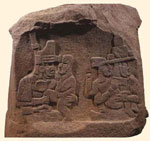|
MAJOR ARCHAEOLOGICAL SITES: PreClassic to PostClassic
LA VENTA (circa 800-300 B.C.)
There are four principal Olmec sites arranged along a 100 mile strip of México’s Atlantic Gulf Coast. Laguna de los Cerros and Tres Zapotes are located in the uplands bordering the Tuxtla Mountains. San Lorenzo and La Venta are located amidst the low flood plains of rivers draining into the ocean. Many archaeologists believe that each of these communities monopolized differing resources (such as salt, clay, limestone, hematite) that they exchanged between themselves together with staple commodities like squash, beans and maize. Following an extraordinary period of growth under San Lorenzo for several hundred years, La Venta became the dominant Olmec ceremonial center by 800 B.C.
 |
Olmec sites. The word Olmec comes from an Aztec historical name for the people who occupied the Gulf Coast. It is derived from their word for “rubber” which was a primary commercial product in the region. We don’t know what the Olmec actually called themselves but they may have spoken a language related to today’s Mixe-Zoque. Click on Image for more detail. |
 |
La Venta, Altar 4. Once endangered by industrial growth in the vicinity of the archaeological zone, La Venta’s monuments are now displayed in a special park located in the heart of the Tabasco state capital of Villahermosa. Archaeologists have proposed that monuments like Altar 4 were actually seats-of-authority upon which chiefs presided over ceremonial occasions. Some of these monuments may even have been re-carved from colossal heads. Click on Image for more detail. |
 |
La Venta consists of ten distinct architectural groups arranged along a north-south axis. Ritual life focused on Mound C, a 100 foot tall adobe pyramid, the largest Olmec edifice of its kind. Its fluted cone shape resembles a volcano, perhaps invoking a mountain in the Tuxtla range from which the stone used in carving the monuments was transported. Click on Image for more detail. |
 |
The sides of Altar 5 portray high ranking personages wearing turbans or wide-brimmed hats and cradling small anthropomorphic creatures possibly representing Olmec spirit forces connected to rain. Click on Image for more detail. |
Previous Page | Sites Index | Next Page
Table of Contents
Return to top of page |





